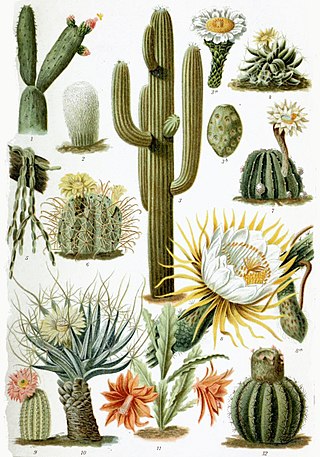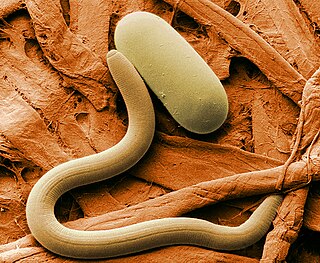
A cactus is a member of the plant family Cactaceae, a family comprising about 127 genera with some 1,750 known species of the order Caryophyllales. The word cactus derives, through Latin, from the Ancient Greek word κάκτος (káktos), a name originally used by Theophrastus for a spiny plant whose identity is now not certain. Cacti occur in a wide range of shapes and sizes. They are native to the Americas, ranging from Patagonia in the south to parts of western Canada in the north, with the exception of Rhipsalis baccifera, which is also found in Africa and Sri Lanka. Cacti are adapted to live in very dry environments, including the Atacama Desert, one of the driest places on Earth. Because of this, cacti show many adaptations to conserve water. For example, almost all cacti are succulents, meaning they have thickened, fleshy parts adapted to store water. Unlike many other succulents, the stem is the only part of most cacti where this vital process takes place. Most species of cacti have lost true leaves, retaining only spines, which are highly modified leaves. As well as defending against herbivores, spines help prevent water loss by reducing air flow close to the cactus and providing some shade. In the absence of true leaves, cacti's enlarged stems carry out photosynthesis.

Heterodera avenae, the cereal cyst nematode or European cyst nematode, is a plant pathogen and an obligate parasite of cereal crops including barley, oats, wheat and rye. Cereal crops infected with this nematode are more susceptible to infection by fungal diseases such as rhizoctonia root rot.
Heterodera cajani is a plant pathogenic nematode affecting pigeonpeas, which is cited as an invasive species.
Heterodera ciceri is a plant pathogenic nematode infecting lentils and chickpeas.
Heterodera cruciferae is a plant pathogenic nematode that predates on cabbages.
Heterodera filipjevi is a plant pathogenic nematode affecting barley.
Heterodera gambiensis is a plant pathogenic nematode affecting pearl millet.
Heterodera goettingiana, the pea cyst nematode, is a plant pathogenic nematode affecting peas.
Heterodera hordecalis is a plant pathogenic nematode affecting barley.
Heterodera latipons, the Mediterranean cereal cyst nematode or wheat cyst nematode, is a plant pathogenic nematode.
Heterodera rosii is a plant pathogenic nematode that attacks chickpeas.

Heterodera schachtii, the beet cyst eelworm or sugarbeet nematode, is a plant pathogenic nematode. It infects more than 200 different plants including economically important crops such as sugar beets, cabbage, broccoli, and radish. H. schachtii is found worldwide. Affected plants are marked by stunted growth, wilting, yellowing, decreased yields, and death. While there are many methods of control, crop rotation with non-susceptible plants is preferred.
Heterodera tabacum is a plant pathogenic nematode affecting Jerusalem cherries.
Heterodera trifolii is a plant pathogenic nematode.
Cyst nematodes may refer to:

Heterodera is a genus of nematodes in the family Heteroderidae. Members of the genus are obligate parasites and different species attack different crops, often causing great economic damage. The genus is unique among nematode genera because of the ability of the female to transform into a tough, brown, cyst which protects the eggs which have been formed within her body. The name heterodera "refers to the different 'skins' of female and cyst."
Heterodera sacchari, the sugarcane cyst nematode, mitotic parthenogenic sedentary endoparasitic nematode. This plant-parasitic nematode infects the roots of sugarcane, and the female nematode eventually becomes a thick-walled cyst filled with eggs. Aboveground symptoms are species specific and are similar to those caused by other Heterodera species. Symptoms include: stunted and chlorotic plants, and reduced root growth. Seedlings may be killed in heavily infested soils.
Heterodera cardiolata is a plant pathogenic nematode.

A pitaya or pitahaya is the fruit of several different cactus species indigenous to the region of southern Mexico and along the Pacific coasts of Guatemala, Costa Rica, and El Salvador. Pitaya is cultivated in East Asia, South Asia, Southeast Asia, the United States, the Caribbean, Australia, Brazil, and throughout tropical and subtropical regions of the world.




